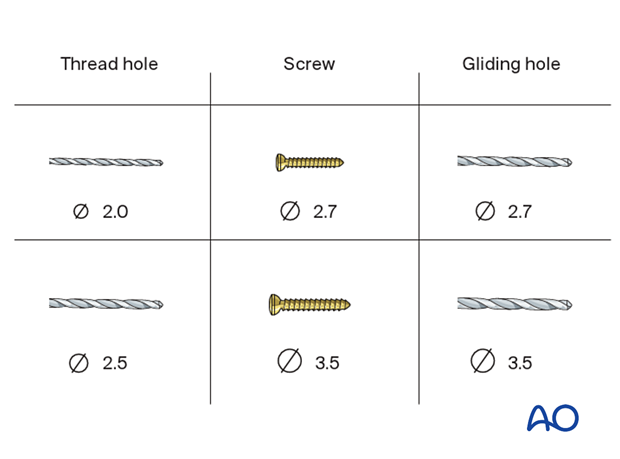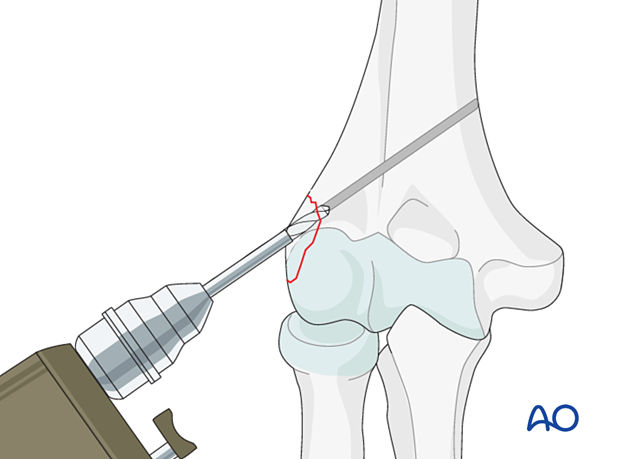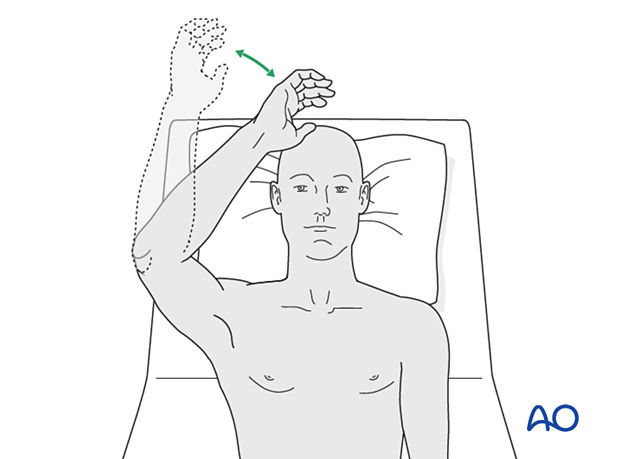ORIF - Screw fixation
1. General considerations
Introduction
The fragment is stabilized with a lag or position screw. Usually, the fragment is small and takes only one screw. If the fragment is large enough, two screws may be used.
It can be useful to incorporate the soft-tissue attachments to the lateral epicondyle by using a washer or sutures.

Screw dimension
The choice between standard screw fixation and cannulated screw fixation is usually dependent on the surgeon’s individual preferences, the equipment available, and the operative and imaging facilities.
Depending on the size of the fracture fragment and patient characteristics, 2.7 and 3.5 mm screws are most commonly used.

2. Patient preparation and approach
Patient positioning
This procedure is usually performed with the patient in a supine position.

Approach
The preferred approach is the direct lateral approach.

3. Open reduction
Mobilizing the fragment
Open the fracture site by mobilizing the fragment.

Clearing the fracture site
Clear the fracture of any hematoma, loose pieces of bone, or interposed tissue.

Reduction
Reduce the fragment and hold it temporarily in place with either a dental hook or a K-wire.

4. Fixation
Drilling
Drill a 2.5 or 2.0 mm hole through the center of the fragment and all the way to and through the opposite cortex, avoiding the olecranon fossa.
Measure for screw length with a depth gauge.

Only in large fragments appropriate for lag screw technique, overdrill with a 3.5 or 2.7 mm drill. However, take care not to split the fragment.

Screw insertion
Insert the screw.
In smaller fragments, a washer may be useful to avoid fragment splitting and incorporate the soft-tissue structures.

5. Final assessment
Visually inspect the fixation and manually check for fracture stability.
Repeat the manual check under image intensification.
6. Aftercare
Introduction
The rehabilitation protocol consists usually of three phases:
- Rehabilitation until wound healing
- Rehabilitation until bone healing
- Functional rehabilitation after bone healing
Immediate aftercare
The arm is bandaged to support and protect the surgical wound.
The arm is rested on pillows in slight flexion of the elbow so that the hand is positioned above the level of the heart.
Short-term splinting may be applied for soft-tissue support.
Neurovascular observations are made frequently.

Hand pumping and forearm rotation exercises are started as soon as possible to reduce lymphedema and to improve venous return in the limb. This helps to reduce postoperative swelling.

Mobilization until wound healing
Gravity-eliminated active assisted exercises of the elbow should be initiated as soon as possible, as the elbow is prone to stiffness:
- The bandages are removed, and the arm rested on a side table
- Flexion/extension of the arm at the elbow is encouraged in a gentle sweeping movement on the tabletop as far as comfort permits (as illustrated)
- Full pronation and supination in protected arm position is encouraged
- Exercises are performed hourly in repetitions, the number of which is governed by comfort
- Between periods of exercise, the elbow is rested in the elevated position for at least the first 48 hours postoperatively
- Keep the arm elevated between periods of exercise until the wound has healed

Rehabilitation until bone healing
Active patient-directed range-of -motion exercises should be encouraged without the routine use of splintage or immobilization.
Avoid forceful motion, repetitive loading, or weight-bearing through the arm.
A simple compressive sleeve can provide proprioceptive feedback which can help regain motion and avoid cocontraction.
No load-bearing (ie, pushing, pulling, or carrying weights) or strengthening exercises are allowed until early fracture healing is established by x-ray and clinical examination.
This is usually a minimum of 8–12 weeks after injury. Weight-bearing on the arm should be avoided until bony union is assured.
The patient should avoid resisted extension activities, especially after a triceps-elevating approach or olecranon osteotomy.
Rehabilitation after bone healing
When the fracture has united, a combination of active functional motion and kinetic chain rehabilitation can be initiated.
Active assisted elbow motion exercises are continued. The patient bends the elbow as much as possible using his/her muscles while simultaneously using the opposite arm to gently push the arm into further flexion. This effort should be sustained for several minutes; the longer, the better.

Next, a similar exercise is performed for extension.

If the patient finds it difficult to accomplish these exercises when seated, then performing the same exercises when lying supine can be helpful.

Implant removal
Generally, the implants are not removed. If symptomatic, hardware removal may be considered after consolidated bony healing, usually no less than 6 months for metaphyseal fractures and 12 months when the diaphysis is involved. The avoidance of the risk of refracture requires activity limitation for some months after implant removal.













